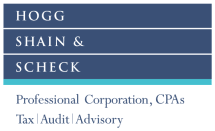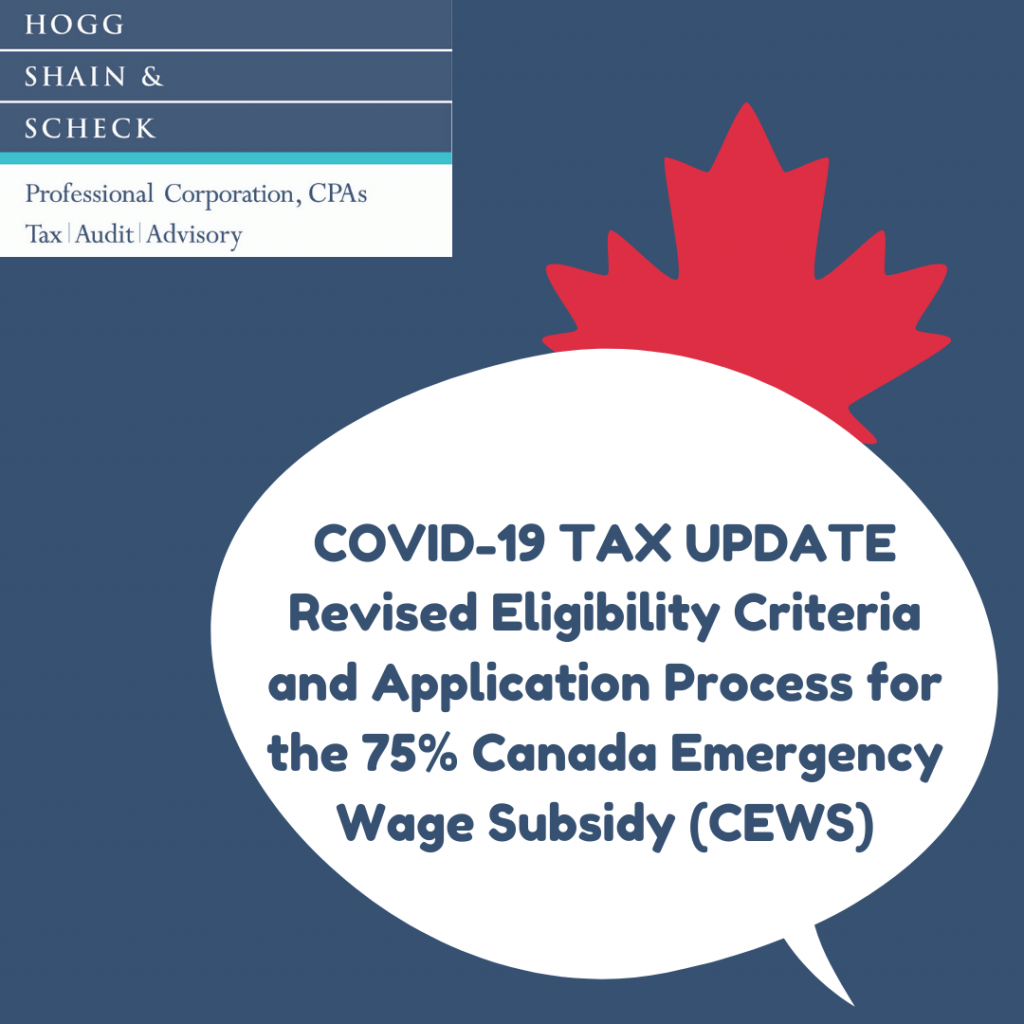COVID-19 Tax Update: Revised Eligibility Criteria and Application Process for the Canada Emergency Wage Subsidy
(Released April 14, 2020)
Update Eligibility Criteria for the Canada Emergency Wage Subsidy
An eligible employer to receive the 75% CEWS benefit includes:
• an individual;
• a corporation (other than a tax-exempt corporation or public institution);
• a registered charity (other than a public institution);
• a person that is tax-exempt because of paragraph 149(1)(e), (j), (k) or (l) of the Income Tax Act (Canada) (other than a public institution);
• a partnership, all of the members of which are described in this paragraph or in any of the above paragraphs; or
• a prescribed organization.
The eligible employer must have:
• experienced a 15% reduction in qualifying revenue for March 2020 compared to March 2019; and,
• a 30% reduction in qualifying revenue in April and May 2020, compared to April and May of 2019, respectively.
Alternatively, an eligible employer may elect to use the average revenues earned in January and February 2020 as the baseline, instead of March, April and May 2019 in making the comparison. If an employer elects to use average revenues for January and February 2020, then they are required to use average revenue for all three months of the program.
Claiming Period for Canada Wage Subsidy
The table below outlines each claiming period, the required reduction in revenue and the reference period for eligibility for CEWS.
| Period | Claiming period | Required reduction in revenue | Reference period for eligibility |
| 1 |
March 15th to April 11, 2020 |
15% | March 2020 over:
· March 2019 or · Average of January and February 2020
|
| 2 | April 12th to May 9, 2020 | 30% | Eligible for Period 1, OR
April 2020 over: · April 2019 or · Average of January and February 2020
|
| 3 | May 10th to June 6, 2020 | 30% | Eligible for Period 2, OR
May 2020 over: · May 2019 or · Average of January and February 2020
|
Applying for CEWS Is Easy:
An eligible employer must:
- file an application with the Canada Revenue Agency (“CRA”) in respect of a qualifying period before October 2020;
- attest that the CEWS application is complete and accurate in all material respects; and
- have had, on March 15, 2020, a Business Number registered with the CRA to make remittances for income tax source deductions.
Amount of Subsidy received from CEWS:
The subsidy amount for a given employee on eligible remuneration paid for the period between March 15 and June 6, 2020 will be the greater of:
- the least of
- 75% of the amount of remuneration paid to the eligible employee in respect of that week,
- $847, and
- if the eligible employee does not deal at arm’s length with the qualifying entity in the qualifying period, nil, and
- the least of
- the amount of eligible remuneration paid to the eligible employee in respect of that week,
- 75 % of the employee’s pre-crisis weekly remuneration (March 15, 2020), and
- $847.
Pre-Crisis Remuneration
Eligible employers may be eligible for a subsidy of up to 100% of the first 75% of pre-crisis remuneration of existing employees. These employers will be expected, where possible, to maintain existing employees’ pre-crisis employment earnings.
The pre-crisis remuneration for a given employee is based on the average weekly remuneration paid between January 1, 2020 and March 15, 2020 inclusively, excluding any seven-day periods in respect of which the employee did not receive remuneration.
Employers will also be eligible for a subsidy of up to 75% of remuneration paid to new employees.
Limit of CEWS and Employer is Eligible to Claim
Unlike the 10% Temporary Wage Subsidy, which limits the benefit to $25,000 per employer, there is no overall limit on the CEWS amount that an eligible employer may claim.
Eligible employers are expected to make their best effort to “top-up” employees’ remuneration to bring them to pre-crisis levels.
Canada Emergency Wage Subsidy Refund for Certain Payroll Contributions:
CEWS also provides a 100% refund for certain employer-paid contributions to Employment Insurance, the Canada Pension Plan, the Quebec Pension Plan, and the Quebec Parental Insurance Plan. This refund covers 100% of employer-paid contributions for eligible employees for each week throughout which those employees are on leave with pay and which the employer is eligible to claim the CEWS.
In general, an employee is considered to be on leave with pay throughout a week, if that employee is remunerated by the employer for that week, but does not perform any work for the employer in that week. This refund is not available for eligible employees that are on leave with pay for only a portion of a week.
This refund is not subject to the weekly maximum benefit per employee of $847 that an eligible employer may claim in respect of the CEWS. There is no overall limit on the refund amount that an eligible employer may claim.
Eligible Remuneration for CEWS:
Eligible remuneration may include salary, wages, and other remuneration like taxable benefits. These are amounts, for which employers will generally be required to withhold or deduct amounts to remit to the Receiver General on account of the employee’s income tax obligation. It does not include a retiring allowance, severance pay, or items such as stock option benefits or the personal use of a corporate vehicle.
A special rule will apply to employees that do not deal at arm’s-length with the employer. Family corporations and professional corporations are the most common examples. The CEWS amount for such employees will be limited to the eligible remuneration paid in any week between March 15 and June 6, 2020, up to a maximum benefit of the lesser of $847 per week and 75% of the employee’s baseline weekly remuneration.
The Canada emergency wage subsidy is only available in respect of non-arm’s length employees employed prior to March 15, 2020.
Calculating Revenues for CEWS:
An eligible employer’s revenue is its revenue in Canada earned from arm’s-length sources. Revenue is calculated using the employer’s normal accounting method, excluding revenues from extraordinary items and amounts on account of capital.
The government clarified that employers will be allowed to calculate their revenue under the accrual method or the cash method, but not a combination of both. Employers will select an accounting method when first applying for the CEWS and be required to use that method for the entire duration of the program.
Corporate groups can choose whether to apply the combined group’s results for each member, or alternatively allow each member of the group to determine results on a standalone basis. While revenue is generally defined to exclude internal group revenues and non-arm’s length revenue, the legislation does provide a means of computing revenue reductions to account for these situations.
Registered charities and non-profit organizations must exclude revenues from non-arm’s length organizations. They will be allowed to choose whether or not to include revenue from government sources as part of the calculation. Once chosen, the same approach will apply throughout the program period.
Eligible Employees for Canada Emergency Wage Subsidy:
An eligible employee is an individual who is employed in Canada.
Eligibility for the CEWS of an employee’s remuneration will be available to employees, other than those who have been without remuneration for 14 or more consecutive days in the eligibility period, i.e., from March 15 to April 11, 2020 from April 12 to May 9, 2020 or from May 10 to June 6, 2020.
CEWS Interaction with the 10% Temporary Wage Subsidy:
Any benefit from the 10% wage subsidy for remuneration paid in a specific period will generally reduce the amount available to be claimed under the CEWS in that same period.
CEWS Interaction with the Work-Sharing Program:
For employers and employees that are participating in a [i] , EI benefits received by employees through the Work-Sharing program reduce the benefit that their employer is entitled to receive under the CEWS.
Government Assistance & CEWS:
The usual treatment of tax credits and other benefits provided by governments apply. As a consequence, the wage subsidy received by an employer is considered government assistance and is included in the employer’s taxable income.
Also be aware that assistance received under either wage subsidy program reduces the amount of remuneration expenses eligible for other federal tax credits calculated on the same remuneration.
Compliance with the Canada Emergency Wage Subsidy:
Eligible employers that engage in artificial transactions to reduce revenue for the purpose of claiming the CEWS will be subject to a penalty equal to 25% of the value of the CEWS amount claimed, in addition to the requirement to repay in full the CEWS that was improperly claimed. Interest at the prescribed rate will also apply to these amounts.
[i] For more information on the Work-Sharing Program, please follow this link: https://www.canada.ca/en/employment-social-development/services/work-sharing.html






